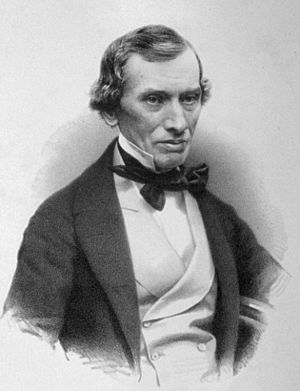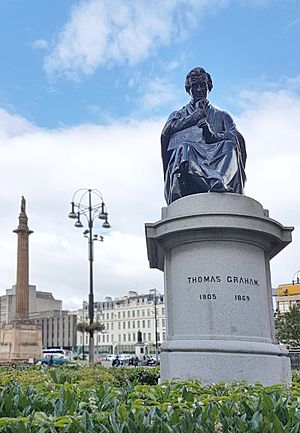Thomas Graham (chemist) facts for kids
Quick facts for kids
Thomas Graham
|
|
|---|---|

Thomas Graham in 1856
|
|
| Born | 21 December 1805 |
| Died | 16 September 1869 (aged 63) |
| Nationality | British |
| Alma mater | University of Glasgow University of Edinburgh |
| Known for |
|
| Awards |
|
| Scientific career | |
| Fields | Chemistry |
| Institutions |
|
| Signature | |
Thomas Graham was a Scottish chemist. He lived from 1805 to 1869. He is famous for his important work with dialysis and how gases spread out. Many people see him as one of the main people who started the study of colloid chemistry.
Contents
Life Story of Thomas Graham
Thomas Graham was born in Glasgow, Scotland. He went to the High School of Glasgow. His father made textiles and wanted Thomas to join the church. But Thomas chose to study at the University of Glasgow in 1819.
Becoming a Chemist
At the university, Thomas became very interested in chemistry. He studied with Professor Thomas Thomson. Professor Thomson was very impressed by the young Thomas. Thomas finished his studies and got his MA degree in 1824.
He later studied medicine at the University of Edinburgh. For a short time, he taught chemistry in Glasgow. In 1828, he became an Honorary Fellow of the Royal Society of Edinburgh. He also won the Society's Keith Medal.
Teaching and Research
In 1830, Thomas Graham became the first chemistry professor at Anderson's Medical School. He also gave lectures at the Glasgow Mechanics' Institution. Later, he moved to London to teach at the University of London. There, he helped start the Chemical Society of London in 1841.
His last job was as the Master of the Mint. This meant he was in charge of making coins for the country. He held this job from 1855 until he passed away. He was the last person to have this specific role.
Thomas Graham died in London. His body was brought back to Glasgow. He was buried in his family's plot at Glasgow Cathedral.
Thomas Graham's Discoveries
Thomas Graham is well-known for studying how gases behave. His work led to two important rules called "Graham's Laws." These laws explain how gases move and mix.
Graham's Laws of Gases
One of Graham's laws is about diffusion. This is when gas particles spread out and mix with other gases. Graham found that lighter gases spread faster than heavier gases. Imagine a smell spreading across a room; it happens faster if the smell particles are light.
The other law is about effusion. This is when a gas escapes through a tiny hole into an empty space. Graham found that gases with lighter particles escape faster. Both of these ideas are sometimes combined into one "Graham's Law."
Pioneering Dialysis
Graham also made big discoveries about dialysis. This is a process used in science and medicine. Today, it's used in kidney dialysis machines. These machines help people whose kidneys don't work well.
Graham studied colloids. These are mixtures where tiny particles are spread throughout another substance. He found a way to separate colloids from other substances using a "dialyzer." This was an early version of the technology used in modern dialysis. His work helped create the field of colloid chemistry.
Understanding Molecules
He also suggested an idea called the association theory. This theory said that substances like cellulose (found in plants) or starch (found in food) were made of smaller molecules. He thought these smaller molecules were held together by unknown forces. This idea was popular for a long time. Later, in the 1920s, another scientist named Hermann Staudinger showed that these substances are actually polymers, which are very large molecules.
Honors and Recognition
Thomas Graham received many awards and honors for his scientific work.
- He became an Honorary Fellow of the Royal Society of Edinburgh in 1828.
- He was made a Fellow of the Royal Society in 1836.
- He was the first President of the Chemical Society of London in 1841.
- He won the Royal Medal twice, in 1837 and 1863.
- He received an honorary doctorate from the University of Oxford in 1853.
- He was awarded the Copley Medal in 1862.
- He also won the Prix Jecker from the Paris Academy of Sciences in 1862.
Lasting Tributes

After his death, people honored Thomas Graham in several ways:
- A statue of him was put up in George Square in Glasgow in 1872.
- The Royal College of Science and Technology named its new Chemistry building the Thomas Graham Building in 1962. This college was a successor to Anderson's Institution, where Graham once worked.
- The main office of the Royal Society of Chemistry in Cambridge, England, is named Thomas Graham House.
See also
 In Spanish: Thomas Graham para niños
In Spanish: Thomas Graham para niños
- Graham's law
- Gaseous diffusion
- Dialysis
- Colloid
- Fick's laws of diffusion

